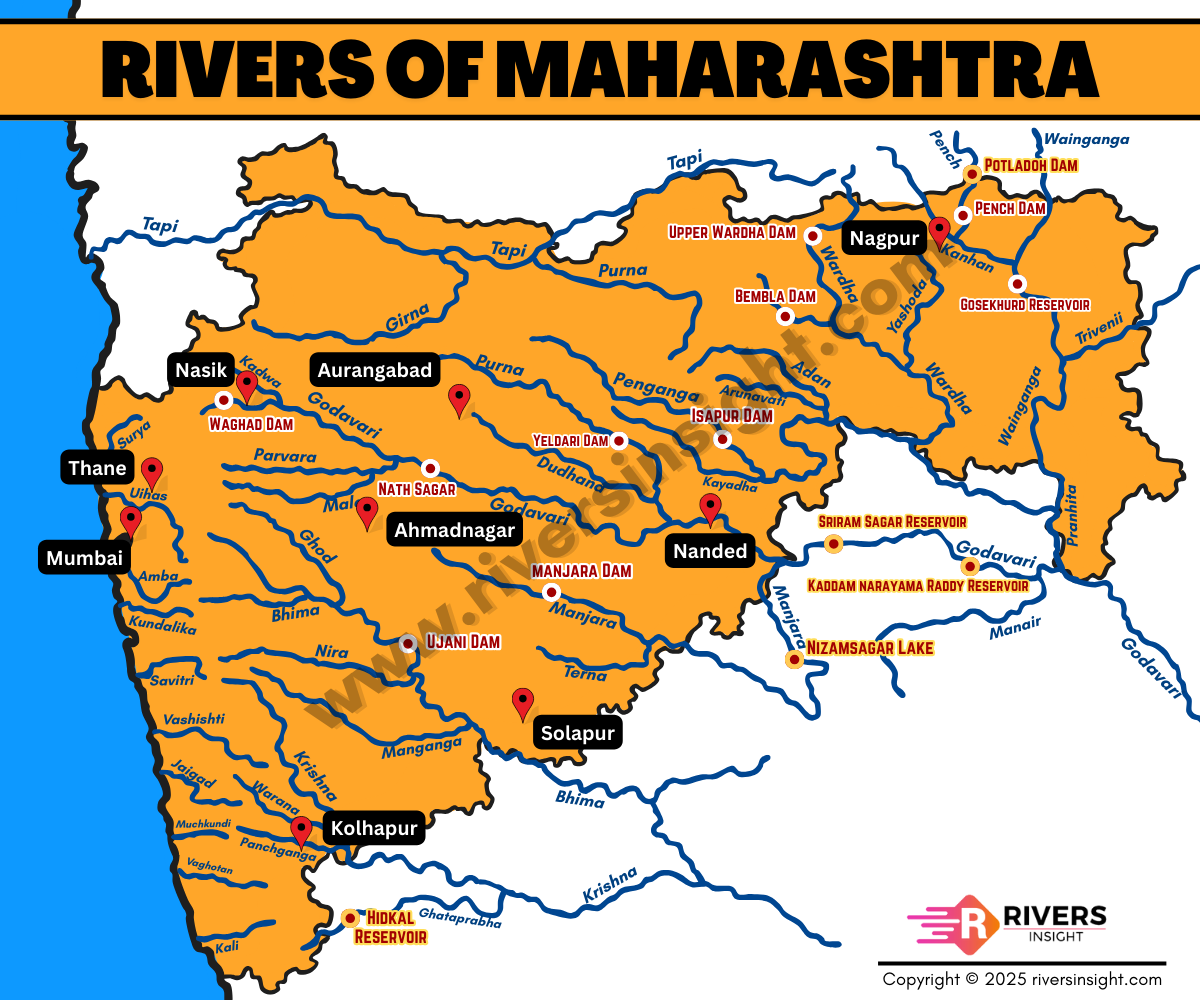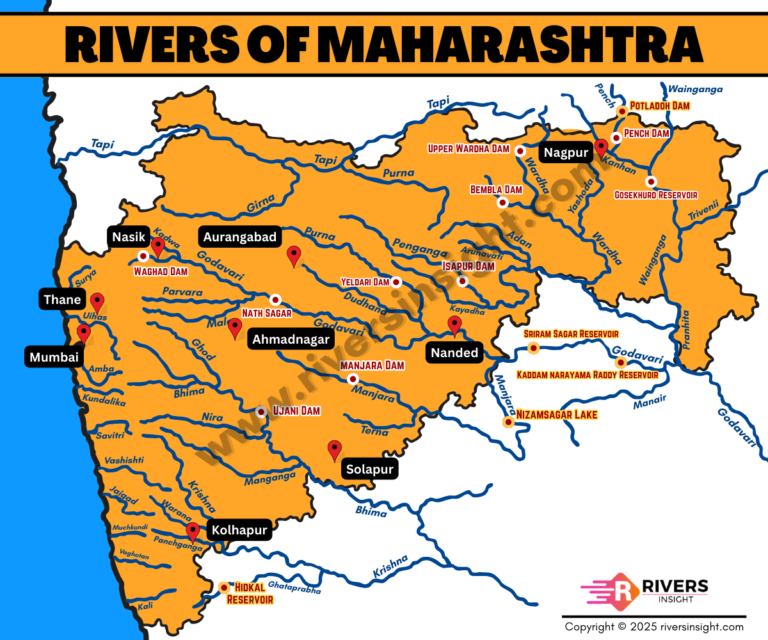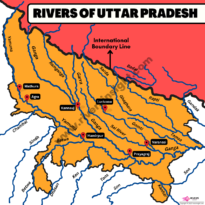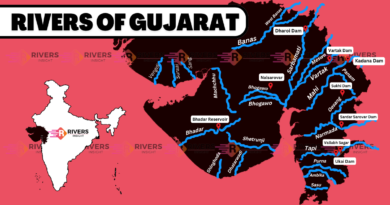List of Major Rivers in Maharashtra & Map
Maharashtra, one of the largest states in India, is located in the western and central part of the country. Specifically, it shares its borders with Gujarat and Madhya Pradesh to the north, Chhattisgarh to the east, Telangana and Karnataka to the south, and Goa and the Arabian Sea to the west. The state’s landscape is shaped by numerous rivers in Maharashtra, most of which originate from the Western Ghats.
Furthermore, Maharashtra is divided into five major river basins: Godavari, Krishna, Tapi, Narmada, and the west-flowing rivers of the Konkan region. Among these, the Godavari River is the longest river in Maharashtra, followed by the Bhima River. Generally, these rivers flow eastward, carving valleys and plateaus across the state’s central and eastern regions.
Table of Contents
River Basins in Maharashtra
- Godavari Basin – The largest in Maharashtra, covering nearly half the state (around 1,52,200 sq. km). It drains central and eastern regions through rivers like Godavari, Purna, and Pravara.
- Krishna Basin – Covers approximately 23% of the state’s area. The Krishna and its tributaries such as Bhima, Koyna, and Nira flow through the southern districts.
- Tapi Basin – Makes up about 17% of Maharashtra’s area. Rivers like Tapi, Purna (Tapi), and Gomai drain the northwestern areas.
- Narmada Basin – Occupies only about 0.5% of the state’s territory in the northwestern border region.
- West Flowing Rivers Basin – Constitutes around 10% of Maharashtra. Includes fast-flowing rivers like Vaitarna, Ulhas, and Damanganga that originate from the Western Ghats and drain into the Arabian Sea.
List of Major Rivers in Maharashtra
1. Godavari River
- Origin: Trimbak Plateau, Nashik district, Maharashtra
- Length: 1,465 km (approx. 720 km in Maharashtra)
- Drainage Area in Maharashtra: ~49% of the total basin
- Flow Direction: West to East
- Major Tributaries in Maharashtra:
- Pravara River
- Purna River
- Manjira River
- Daru River
- Kadva River
- Confluence: Bay of Bengal at Antarvedi, Andhra Pradesh
- Districts Covered: Nashik, Ahmednagar, Beed, Parbhani, Nanded
2. Krishna River
- Origin: Mahabaleshwar, Satara district, Maharashtra
- Length: 1,400 km (approx. 300 km in Maharashtra)
- Drainage Area in Maharashtra: ~69,425 sq. km
- Flow Direction: West to East
- Major Tributaries in Maharashtra:
- Koyna River
- Panchganga River
- Venna River
- Dudhaganga River
- Confluence: Bay of Bengal, Andhra Pradesh
- Districts Covered: Satara, Sangli, Kolhapur
3. Bhima River
- Origin: Bhimashankar Hills, Pune district
- Length: 861 km
- Flow Direction: Northwest to Southeast
- Major Tributaries:
- Indrayani River
- Mula-Mutha River
- Ghod River
- Nira River
- Confluence: Krishna River in Karnataka
- Districts Covered: Pune, Solapur
4. Tapi River (Tapti)
- Origin: Multai, Madhya Pradesh
- Length: 724 km (approx. 200 km in Maharashtra)
- Flow Direction: East to West (into Arabian Sea)
- Major Tributaries in Maharashtra:
- Purna River (Tapi tributary, different from Godavari’s Purna)
- Bori River
- Gomai River
- Confluence: Arabian Sea near Surat, Gujarat
- Districts Covered: Jalgaon, Dhule, Nandurbar
5. Wardha River
- Origin: Satpura Range, Madhya Pradesh
- Length: 528 km (major portion in Maharashtra)
- Major Tributaries in Maharashtra:
- Wena River
- Bembla River
- Penganga River
- Merges with: Wainganga River to form Pranhita River (Godavari tributary)
- Districts Covered: Nagpur, Wardha, Yavatmal
Other Important Rivers in Maharashtra
| River Name | Origin | Confluence |
|---|---|---|
| Purna (Godavari) | Ajanta Hills, Aurangabad | Godavari at Purna Sangam, Nanded |
| Mula-Mutha | Western Ghats near Pune | Bhima River |
| Koyna | Mahabaleshwar, Satara | Krishna River |
| Penganga | Ajantha Hills, Maharashtra | Wardha River |
| Indrayani | Lonavala region, Sahyadris | Bhima River |
| Ulhas | Sahyadri Hills, Raigad | Arabian Sea near Mumbai |
| Vaitarna | Trimbak Hills, Nashik | Arabian Sea |
| Damanganga | Sahyadris, Nashik | Arabian Sea at Daman |

Longest River in Maharashtra
The Godavari River is the longest river in Maharashtra, flowing for approximately 720 km within the state. Originating from Trimbak in Nashik district, it traverses major regions of central and eastern Maharashtra before entering Telangana. The Bhima River, a major tributary of the Krishna River, is the second longest river in Maharashtra, covering around 450 km within the state.
Rivers Flowing Westward (into Arabian Sea)
- Tapi River
- Ulhas River
- Vaitarna River
- Savitri River
- Damanganga River
- Shastri River
- Muchkundi
- Amba
These rivers are generally shorter, fast-flowing, and originate from the Western Ghats.
Rivers Flowing Eastward (into Bay of Bengal)
- Godavari River
- Krishna River
- Bhima River
- Wardha and Wainganga Rivers
- Purna (Godavari tributary)
- Penganga
These rivers are longer, flowing across the Deccan Plateau before merging into larger systems.
Major Dams in Maharashtra
Maharashtra is home to one of the largest numbers of dams in India, with over 1,800 major, medium, and minor dams constructed for irrigation, drinking water, and hydroelectric purposes. These dams are primarily built across the Godavari, Krishna, Tapi, and west-flowing rivers. Below are some of the most significant dams in the state:
- Jayakwadi Dam – Godavari River
- Koyna Dam – Koyna River
- Ujjani Dam – Bhima River
- Yeldari Dam – Purna River
- Wilson Dam (Bhandardara Dam) – Pravara River
- Upper Vaitarna Dam – Vaitarna River
- Totladoh Dam – Pench River
- Girna Dam – Girna River
- Mula Dam – Mula River
- Khadakwasla Dam – Mutha River
- Hatnur Dam – Tapi River
- Isapur Dam – Penganga River
- Panshet Dam – Ambi River
- Radhanagari Dam – Bhogavati River
- Dhamna Dam – Wainganga River
If you’re interested in learning about rivers beyond Maharashtra, take a look at our detailed guide and map of the major rivers across India and how they shape the country.




